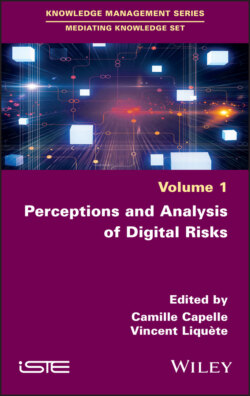Читать книгу Perceptions and Analysis of Digital Risks - Группа авторов - Страница 9
Risk perception
ОглавлениеHow do we represent risks in our minds? The “existence” of risk can be split up into the real danger perceived and the representation we have of it. Between real and perceived risks, real and imaginary, for all the actors – in this case, teachers and students – the risk incurred (factual aspect) is as important as the perception of the digital “cause” linked to it. The postures engaged find their reason: avoidance, risk literacy, the staging of activities that ensure awareness (fact-checking), reflexive practices, etc. All of the actions undertaken, the literacy of the risk and the awareness of the “cause” of the risk, have to be taken into account. All of the actions undertaken, and the articulation of risk, are based on a perception that contributes to its reality. Representations thus play a strategic role in prevention and in the capacity of individuals to conceive and define risk. The meaning given, what “we think we are doing” (in the sense of Bruner5), brings together the inner and outer facets of the situation. The perception of risk does not necessarily conform to its reality; but it is the reality of the action it supports. The representations (individual and shared subjectivation) interfere with the uses as much as those which construct them. The represented mode belongs to the work; it becomes a critical point. Articulated with reality, integrated with a reflexive thought, the perception of the risk becomes a lever for our practices.
Those who act in a digital environment operate on different beliefs and hypotheses. They concern the conditions of use and the perception of possible perils. The contributions in the book focus on the perceptions and postures involved in professional and/or learning activities, on the perceptions of the actors involved in learning and teaching activities. It is described by teenagers as “a big scary nebula” (Cordier op. cit.). For some, the risks can be considered as negative or potentially dangerous effects of informational mediations: for others, the digital environment offers a resilience to risk. The attribution of the amplification or reasoned treatment of risks to digital technology calls the meaning of education into question. But are we speaking the same language? A report published in 2008 by Christine Dioni6 entitled “The student’s job and the teacher’s job in the digital age” emphasized the issues of discrepancy between the perceptions of students and those of teachers, as well as between the perceptions and reality of practices. The student’s mirror is the “school’s” perceptions of digital technology, which do not necessarily correspond to those of their peers. The expression of teenagers’ experience becomes a driving force for the necessary reflexivity for practices. The teachers themselves keep personal practices and professional practices at a distance7. Perceptions of the digital world and its uses are thus linked to the informational experience.
